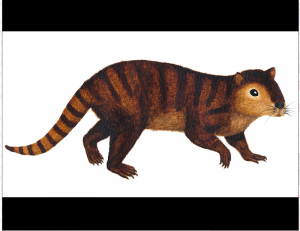Good morning, Whitewater.
Thursday in town will be warm, with a high of seventy-six, and an even chance of afternoon thunderstorms. Sunrise is 7:00 and sunset 6:23, for 11h 22m 56s of daytime. The moon is a waning crescent with 17.3% of its visible disk illuminated.
Millions of years ago, the great reptiles of this planet vanished from existence. There were, however, other animals living at that time – including small mammals – that survived even as the dinosaurs waned into extinction. Among them was Kimbetopsalis simmonsae:
While an asteroid impact, earthquakes and volcanoes wiped out much of life on earth, one survivor apparently emerged, a furry, buck-toothed creature science has dubbed Kimbetopsalis simmonsae.
Identified from fossils, the new species was a member of a group of mammals known as multituberculates, named for the many cusps, or tubercles, found on their teeth.
The rodent-like animals lived alongside the dinosaurs, but unlike the doomed reptilian giants, they managed to live for another 30 million years after the asteroid that pushed the dinosaurs off the evolutionary stage.
What was bad for the dinosaurs proved a boon to Kimbetopsalis, researchers explain.
After the asteroid impact pushed many species to extinction, “all this ecological space became available and the mammals went a bit nuts,” says University of Edinburgh paleontologist Sarah Shelley, co-author of a published study on the discovery.
Via Fossil Find Is Ancient Beaver-Like Mammal That Outlived The Dinosaurs @ Tech Times.
Go mammal, or go home, it seems.
On this day in 1871, fire devastates Chicago and Wisconsin:
The Great Chicago Fire was a conflagration that burned from Sunday, October 8, to early Tuesday, October 10, 1871. The fire killed up to 300 people, destroyed roughly 3.3 square miles (9 km2) of Chicago, Illinois, and left more than 100,000 residents homeless.[1] Though the fire was one of the largestU.S. disasters of the 19th century, and destroyed much of the city’s central business district, Chicago was rebuilt and continued to grow as one of the most populous and economically important American cities. The same night the fire broke out, an even deadlier fire annihilated Peshtigo, Wisconsin, and other villages and towns north of Green Bay, Wisconsin.
The Peshtigo fire took more lives than any other in American history:
1871 – Peshtigo Fire
On this date Peshtigo, Wisconsin was devastated by a fire which took 1,200 lives. The fire caused over $2 million in damages and destroyed 1.25 million acres of forest. This was the greatest human loss due to fire in the history of the United States. The Peshtigo Fire was overshadowed by the Great Chicago fire which occurred on the same day, killing 250 people and lasting three days. While the Chicago fire is said to have started by a cow kicking over a lantern, it is uncertain how the Peshtigo fire began. [Source:Wisconsin Magazine of History].
A Google a Day asks a geography question:
What area with nearly 2 million life forms was created to protect the wildlife of the country with the largest economy in Africa?

